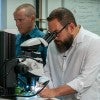Rice Biotech Launch Pad adds William McKeon to external advisory board
March 14, 2024
Rice University today announced the addition of William (Bill) McKeon to its external advisory board for the Rice Biotech Launch Pad, a Houston-based accelerator focused on expediting the translation of the university’s health and medical technology discoveries into cures.
Rice receives $2.5M grant to support inclusive STEM education
November 21, 2023
The Howard Hughes Medical Institute awarded Rice University with $2.5 million spanning over five years as part of its Driving Change initiative designed to connect research universities that are working to build inclusive learning environments for students in science, technology, engineering and mathematics.
Wearable art heels sport tree wart texture
November 17, 2023
A Rice student used galls — plant tissue growths caused by small wasps — to decorate a pair of shoes as part of an art project, creating some online buzz when a picture of the heels were posted on social media.
Rice researcher scans tropical forest with mixed-reality device
October 19, 2023
Rice University scientists incorporated a Microsoft HoloLens mixed-reality headset with custom-built open-source software to record and store mammal habitat data in the Udzungwa Mountains National Park in Tanzania, showing that there was greater biodiversity where more vegetation was measured.
Decontamination method zaps pollutants from soil
October 17, 2023
A rapid, high-heat electrothermal soil remediation process developed by Rice scientists and collaborators at the United States Army Engineer Research and Development Center flushes out both organic pollutants and heavy metals in seconds without damaging soil fertility.
Rice Biotech Launch Pad introduces external advisory board
October 4, 2023
Rice University today announced its external advisory board for the Rice Biotech Launch Pad, the new accelerator focused on expediting the translation of the university’s health and medical technology discoveries into cures.
You can leave your gloves on: Rice-developed material burns viruses, safe for skin
September 11, 2023
A new material that packs deadly heat for viruses on its outer surface while staying cool on the reverse side could be used to make sustainable, multiuse personal protective equipment. Marquise Bell, a Rice graduate student who is the lead author of the research, was also part of this year’s NextProf Nexus workshop, a national, competitive faculty development program for engineering students from underrepresented groups.















